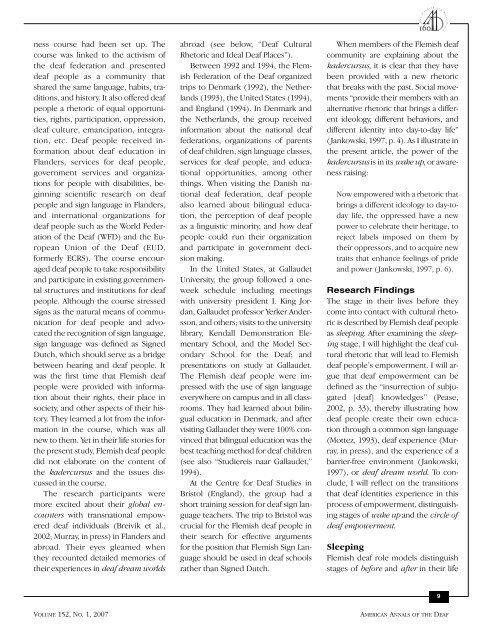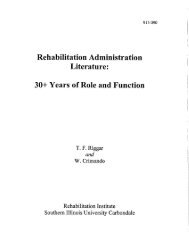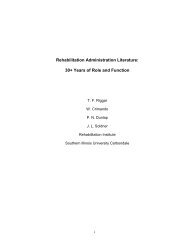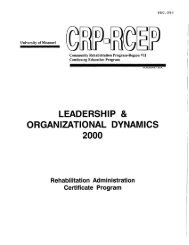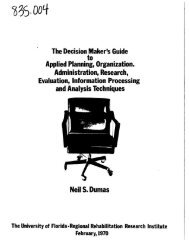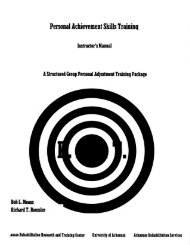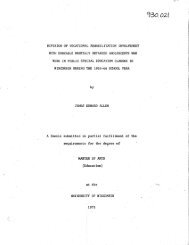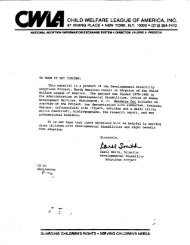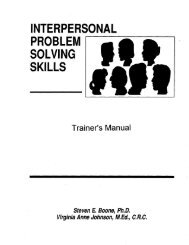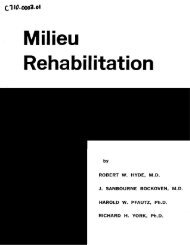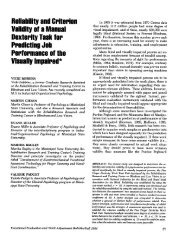Meeting Global Deaf Peers, Visiting Ideal Deaf Places ... - NCRTM
Meeting Global Deaf Peers, Visiting Ideal Deaf Places ... - NCRTM
Meeting Global Deaf Peers, Visiting Ideal Deaf Places ... - NCRTM
You also want an ePaper? Increase the reach of your titles
YUMPU automatically turns print PDFs into web optimized ePapers that Google loves.
ness course had been set up. The<br />
course was linked to the activism of<br />
the deaf federation and presented<br />
deaf people as a community that<br />
shared the same language, habits, traditions,<br />
and history. It also offered deaf<br />
people a rhetoric of equal opportunities,<br />
rights, participation, oppression,<br />
deaf culture, emancipation, integration,<br />
etc. <strong>Deaf</strong> people received information<br />
about deaf education in<br />
Flanders, services for deaf people,<br />
government services and organizations<br />
for people with disabilities, beginning<br />
scientific research on deaf<br />
people and sign language in Flanders,<br />
and international organizations for<br />
deaf people such as the World Federation<br />
of the <strong>Deaf</strong> (WFD) and the European<br />
Union of the <strong>Deaf</strong> (EUD,<br />
formerly ECRS). The course encouraged<br />
deaf people to take responsibility<br />
and participate in existing governmental<br />
structures and institutions for deaf<br />
people. Although the course stressed<br />
signs as the natural means of communication<br />
for deaf people and advocated<br />
the recognition of sign language,<br />
sign language was defined as Signed<br />
Dutch, which should serve as a bridge<br />
between hearing and deaf people. It<br />
was the first time that Flemish deaf<br />
people were provided with information<br />
about their rights, their place in<br />
society, and other aspects of their history.<br />
They learned a lot from the information<br />
in the course, which was all<br />
new to them. Yet in their life stories for<br />
the present study, Flemish deaf people<br />
did not elaborate on the content of<br />
the kadercursus and the issues discussed<br />
in the course.<br />
The research participants were<br />
more excited about their global encounters<br />
with transnational empowered<br />
deaf individuals (Breivik et al.,<br />
2002; Murray, in press) in Flanders and<br />
abroad. Their eyes gleamed when<br />
they recounted detailed memories of<br />
their experiences in deaf dream worlds<br />
abroad (see below, “<strong>Deaf</strong> Cultural<br />
Rhetoric and <strong>Ideal</strong> <strong>Deaf</strong> <strong>Places</strong>”).<br />
Between 1992 and 1994, the Flemish<br />
Federation of the <strong>Deaf</strong> organized<br />
trips to Denmark (1992), the Netherlands<br />
(1993), the United States (1994),<br />
and England (1994). In Denmark and<br />
the Netherlands, the group received<br />
information about the national deaf<br />
federations, organizations of parents<br />
of deaf children, sign language classes,<br />
services for deaf people, and educational<br />
opportunities, among other<br />
things. When visiting the Danish national<br />
deaf federation, deaf people<br />
also learned about bilingual education,<br />
the perception of deaf people<br />
as a linguistic minority, and how deaf<br />
people could run their organization<br />
and participate in government decision<br />
making.<br />
In the United States, at Gallaudet<br />
University, the group followed a oneweek<br />
schedule including meetings<br />
with university president I. King Jordan,<br />
Gallaudet professor Yerker Andersson,<br />
and others; visits to the university<br />
library, Kendall Demonstration Elementary<br />
School, and the Model Secondary<br />
School for the <strong>Deaf</strong>; and<br />
presentations on study at Gallaudet.<br />
The Flemish deaf people were impressed<br />
with the use of sign language<br />
everywhere on campus and in all classrooms.<br />
They had learned about bilingual<br />
education in Denmark, and after<br />
visiting Gallaudet they were 100% convinced<br />
that bilingual education was the<br />
best teaching method for deaf children<br />
(see also “Studiereis naar Gallaudet,”<br />
1994).<br />
At the Centre for <strong>Deaf</strong> Studies in<br />
Bristol (England), the group had a<br />
short training session for deaf sign language<br />
teachers. The trip to Bristol was<br />
crucial for the Flemish deaf people in<br />
their search for effective arguments<br />
for the position that Flemish Sign Language<br />
should be used in deaf schools<br />
rather than Signed Dutch.<br />
When members of the Flemish deaf<br />
community are explaining about the<br />
kadercursus, it is clear that they have<br />
been provided with a new rhetoric<br />
that breaks with the past. Social movements<br />
“provide their members with an<br />
alternative rhetoric that brings a different<br />
ideology, different behaviors, and<br />
different identity into day-to-day life”<br />
(Jankowski, 1997, p. 4). As I illustrate in<br />
the present article, the power of the<br />
kadercursus is in its wake up, or awareness<br />
raising:<br />
Now empowered with a rhetoric that<br />
brings a different ideology to day-today<br />
life, the oppressed have a new<br />
power to celebrate their heritage, to<br />
reject labels imposed on them by<br />
their oppressors, and to acquire new<br />
traits that enhance feelings of pride<br />
and power (Jankowski, 1997, p. 6).<br />
Research Findings<br />
The stage in their lives before they<br />
come into contact with cultural rhetoric<br />
is described by Flemish deaf people<br />
as sleeping. After examining the sleeping<br />
stage, I will highlight the deaf cultural<br />
rhetoric that will lead to Flemish<br />
deaf people’s empowerment. I will argue<br />
that deaf empowerment can be<br />
defined as the “insurrection of subjugated<br />
[deaf] knowledges” (Pease,<br />
2002, p. 33), thereby illustrating how<br />
deaf people create their own education<br />
through a common sign language<br />
(Mottez, 1993), deaf experience (Murray,<br />
in press), and the experience of a<br />
barrier-free environment (Jankowski,<br />
1997), or deaf dream world. To conclude,<br />
I will reflect on the transitions<br />
that deaf identities experience in this<br />
process of empowerment, distinguishing<br />
stages of wake up and the circle of<br />
deaf empowerment.<br />
Sleeping<br />
Flemish deaf role models distinguish<br />
stages of before and after in their life<br />
VOLUME 152, NO. 1, 2007 AMERICAN ANNALS OF THE DEAF<br />
160<br />
O n e H u n d r e d a n d S i x t y Y e a r s<br />
9


